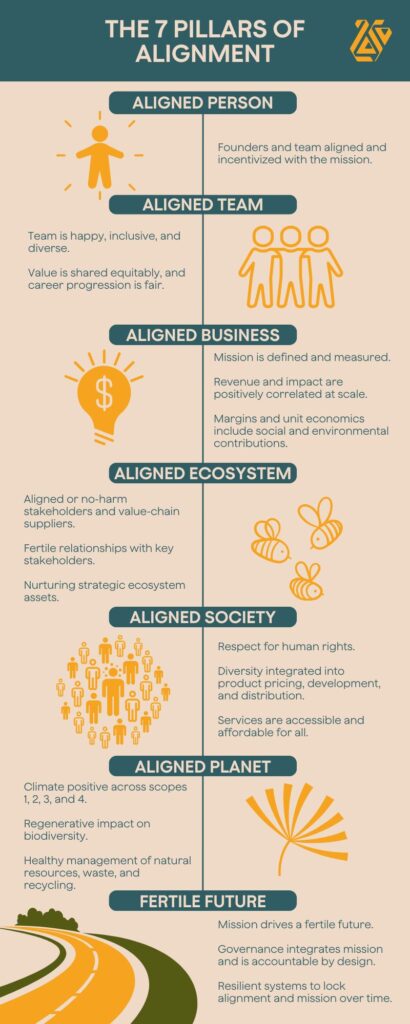
At 2050, in collaboration with We Are Human, we have developed the Alignment Method, a holistic framework designed to guide organizations toward long-term and success. The seven pillars presented here are key indicators of alignment (KAI), serving as benchmarks to assess and maintain coherence across individuals, teams, businesses, ecosystems, society and planet.
Alignment is essential for creating organizations that are resilient, impactful, and mission-driven. Each pillar highlights a critical aspect of alignment necessary to address today’s challenges while building a fertile future.
The 7 Pillars
- ALIGNED PERSON Founders and teams are aligned with the company’s mission and incentivized to drive meaningful progress.
- ALIGNED TEAM A happy, inclusive, and diverse team where value is shared equitably and career growth is fair for everyone.
- ALIGNED BUSINESS A mission that is clearly defined and measured, ensuring revenue growth and positive impact are correlated at scale.
- ALIGNED ECOSYSTEM Building relationships with stakeholders and value-chain suppliers that nurture a sustainable and no-harm ecosystem.
- ALIGNED SOCIETY Promoting human rights, integrating diversity into products, and ensuring affordable and accessible services for all.
- ALIGNED PLANET Achieving a climate-positive footprint through regenerative practices, resource management, and promoting biodiversity.
- FERTILE FUTURE Governance and structures that lock in the mission, fostering long-term resilience and a positive net impact on society and the planet.
Why Alignment Matters
These seven pillars provide indicators for organizations to align their mission, operations, and goals with principles of triple performance. By integrating alignment at every level—from individuals to ecosystems—businesses can achieve:
- Holistic decision-making
- Resilient and long-term
- Measurable positive impact
The Alignment Framework allows organizations to take a step back, assess their actions against long-term goals, and move forward with clarity and purpose.
Building a Fertile Future
At 2050, we use this framework to guide our portfolio companies, helping them define their alignment strategy with tailored objectives. These pillars not only ensure compliance with sustainability standards but also drive real, measurable progress toward a fertile future.

